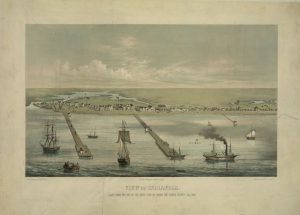
As Hurricane Harvey headed for the Gulf Coast of Texas this past month, my thoughts turned toward a distant connection of mine commemorated in an old Indianola, Texas, cemetery: Continue reading A name and a history

As Hurricane Harvey headed for the Gulf Coast of Texas this past month, my thoughts turned toward a distant connection of mine commemorated in an old Indianola, Texas, cemetery: Continue reading A name and a history
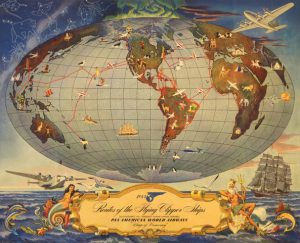
As my grandfather[1] prepared to graduate from college, he was ready to cast off academics and explore the world instead of following his father into a law career. Generations of his sea-faring family had literally charted the way, and the possibilities beckoned to him every time he gazed out the windows of his home towards San Francisco’s (then bridgeless) Golden Gate.
He signed on as an ordinary seaman aboard the Hollywood, a World War I-era freighter in McCormick Steamship Company’s Pacific-Argentine-Brazil Line, and his salary was $45 a month plus room and board … such as it was. Continue reading Pacific Clipper
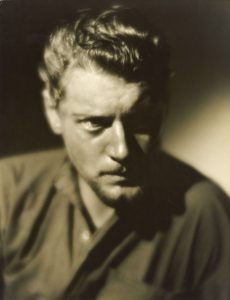
Given the range of databases like Wikipedia and IMDb (more formally The Internet Movie Database), it can be surprising to find a scrap of biographical material that has not been covered. I encountered this paradox recently, when writing up notes on some photographs I’ve bought of the actors Ralph Forbes (1904–1951) and his mother Mary Forbes (1879–1974). Ralph Forbes Taylor was born 30 September 1904 and baptized in the parish of Streatham, Surrey – now part of the Borough of Lambeth in Greater London – the son of Ernest John Taylor and his wife Ethel Louise. The Taylors lived at 142 Gleneagle Road in Streatham (where Ralph was presumably born), and Ernest was a commercial traveler.[1]
But who was Ernest John Taylor? And who was his wife, Ethel Louise, who would in time become the character actress Mary Forbes?[2] Continue reading The name is a mystery

Following up on my recent blog post about genealogical memory (“What do you know?”), I took a fresh look at some persistent brick walls in my mother’s family. The blog post – and a 5-generation fan chart template I got from two colleagues – led me to reflect on whether anything more could be gleaned about the background of my great-great-grandfather, William Boucher Jr. (1822–1899) of Baltimore, Maryland.
The answer, I’m happy to say, is “Yes”! Continue reading Boucher gleanings

Last month, my wife and I took a vacation to Madrid. While Spanish is my wife’s largest “pre-1492” ethnic background (the others being African and Native-American), I have yet to trace an ancestor who was actually born anywhere besides the Dominican Republic. The furthest I’ve gone is to an ancestor born about 1713, who appears on an 1812 census in her father’s hometown of San Francisco de Macoris. (See this post for information on some of my wife’s Dominican Republic ancestry.)
However, through a few of my own documented “royal” lines, I end up with a few cases of Spanish ancestry through my colonial British forebears. On our trip to Madrid, we walked through the Buen Retiro Park and outside the Royal Palace of Madrid, both of which have numerous statues of rulers of various Spanish kingdoms (Castile, Aragon, Leon, Barcelona, etc.), as well as monarchs after unification with the marriage of Ferdinand and Isabella. Continue reading Genealogical connections to Spain
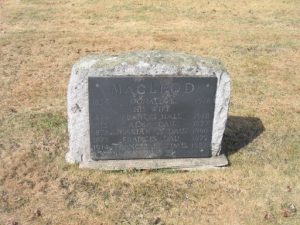 Some of my ancestors are just plain pesky. We all have them, those ancestors who refuse, for seemingly no good reason other than to annoy us, to cooperate with our efforts to document them. For years I had tried to verify the parents of my maternal great-grandfather, Daniel McLeod, without any success. That he was born in New Brunswick, Canada in 1834 without any known church affiliation did nothing to help. Communications with the helpful staff at the Provincial Archives proved to me that I did not have enough information for a specific search of church birth records, so I searched all available church records, still without success. Continue reading Pesky people
Some of my ancestors are just plain pesky. We all have them, those ancestors who refuse, for seemingly no good reason other than to annoy us, to cooperate with our efforts to document them. For years I had tried to verify the parents of my maternal great-grandfather, Daniel McLeod, without any success. That he was born in New Brunswick, Canada in 1834 without any known church affiliation did nothing to help. Communications with the helpful staff at the Provincial Archives proved to me that I did not have enough information for a specific search of church birth records, so I searched all available church records, still without success. Continue reading Pesky people

As researchers, we all hit brick walls when doing genealogy. In my search, there’s a part of my family that just doesn’t want to be found! It can be very discouraging – and, if you’re like me, you become obsessed with uncovering the hidden family members and all the secrets they possess.
My grandmother was born Ada Angel Seguin in 1915 in Rhode Island to George Seguin and Nora Caron. Ada’s father, George, had a well-documented life and his family search was a breeze. But George’s wife Nora Caron is where my research started to unravel. Nora has always been a bit of a mystery for my family. The stories that have been passed down from my aunt say that Nora read tea leaves and had an ‘open-door policy’ in Rhode Island for all that were “lost” or needed a place to stay overnight. What a wonderful individual to have in your family! Continue reading A circus family
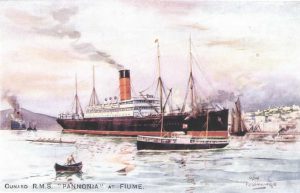
One of my perennial and poignant brick walls is the story behind my wife Nancy’s maternal grandmother Anna Barkassy Pouget (1883–1921). Annie, as she is often called, arrived from Hungary with her father Andràs, an attorney, and passed through Ellis Island on 30 January 1906.[i] Annie’s story is like that of many other turn-of-the-twentieth-century Ellis Island immigrants in that her family name offers only a limited sense of her identity.[ii] Annie and her father traveled together; the passenger manifest reflects scant clues as to who or what they might be leaving behind in the old country – and negligible information regarding their business here on arrival. Continue reading Once an heiress

Whenever I am working in records or sites from another country – and thus not in the English language – I do my best to leave them in that language, especially if my only option for translation is that which is built into the browser software. A recent consultation request brought this issue front and center.
The request for the consultation was confirmation that the two families the researcher had found in the 1910 census were indeed the same family. Continue reading Weeding by another name
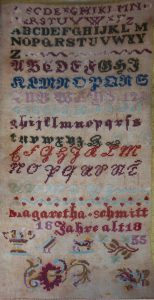 When I first started researching my family I found an antique cross-stitch sampler that was passed down through my maternal grandmother’s family. I was eager to discover which of my ancestors had made it and I thought it should be easy to figure out. After all, it spelled out the stitcher’s name and age.
When I first started researching my family I found an antique cross-stitch sampler that was passed down through my maternal grandmother’s family. I was eager to discover which of my ancestors had made it and I thought it should be easy to figure out. After all, it spelled out the stitcher’s name and age.
First, I examined the sampler. It was faded but still legible and was sewn with Roman and Gothic alphabets, as well as floral and animal motifs. It also contained the words “Magaretha Schmitt 16 Jahre alt 1855.” The German “Jahre alt” translated to “years old.” This would make Magaretha 16 years old when she finished the sampler in 1855. I concluded she was probably born about 1839 and likely of German descent because of the German language and alphabets. Continue reading Who was Magaretha Schmitt?